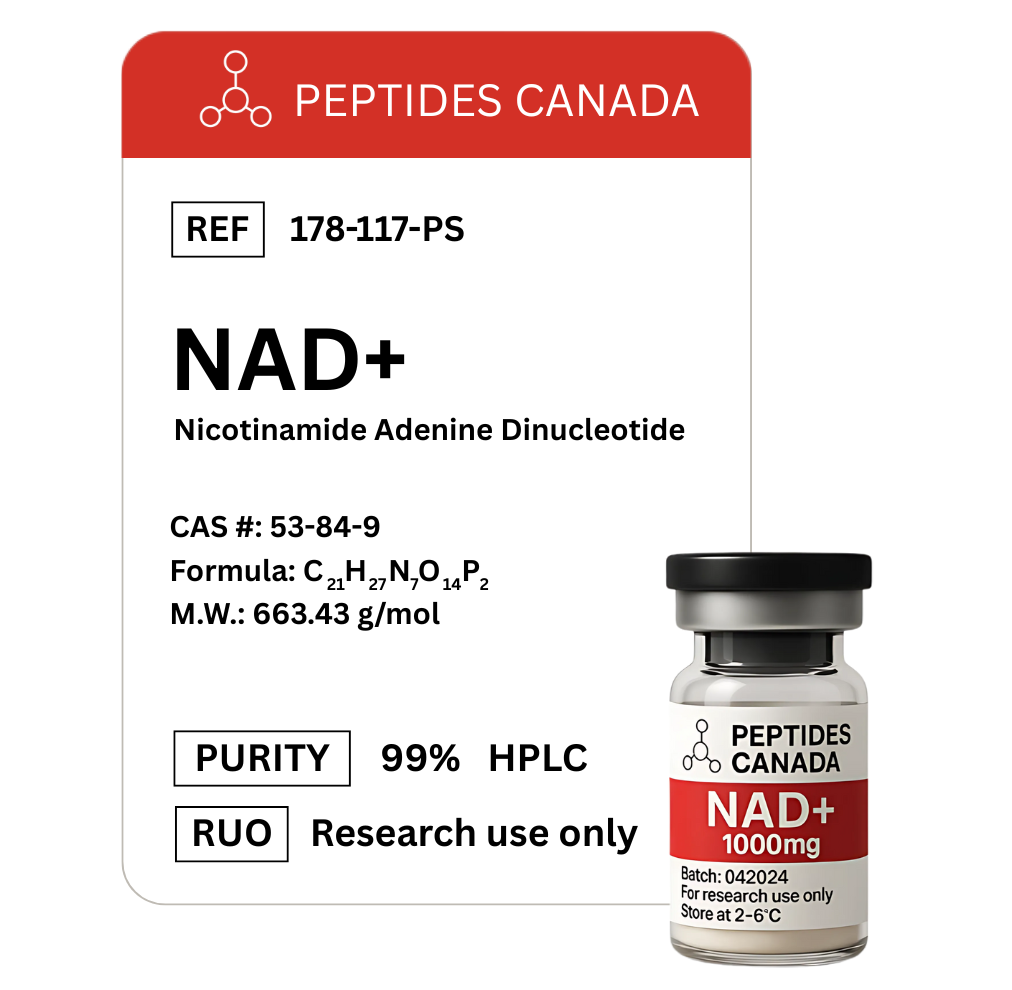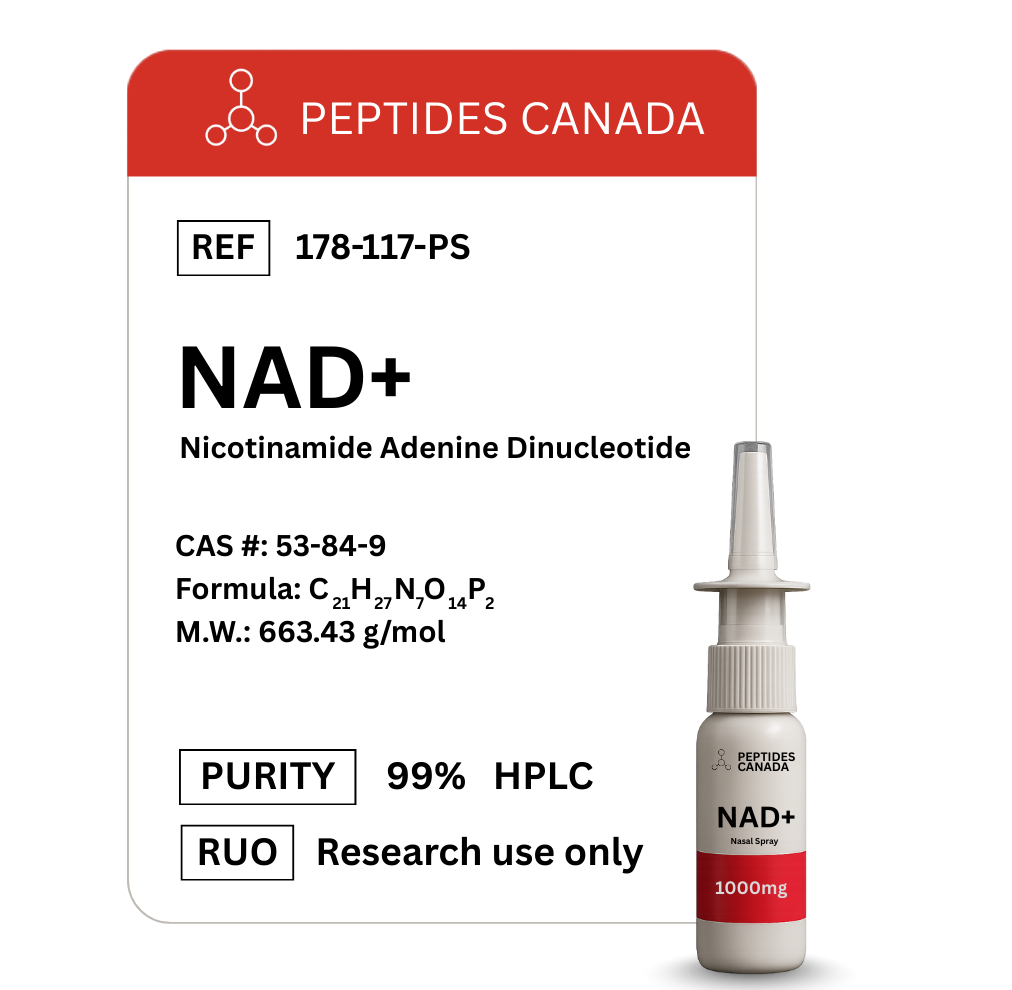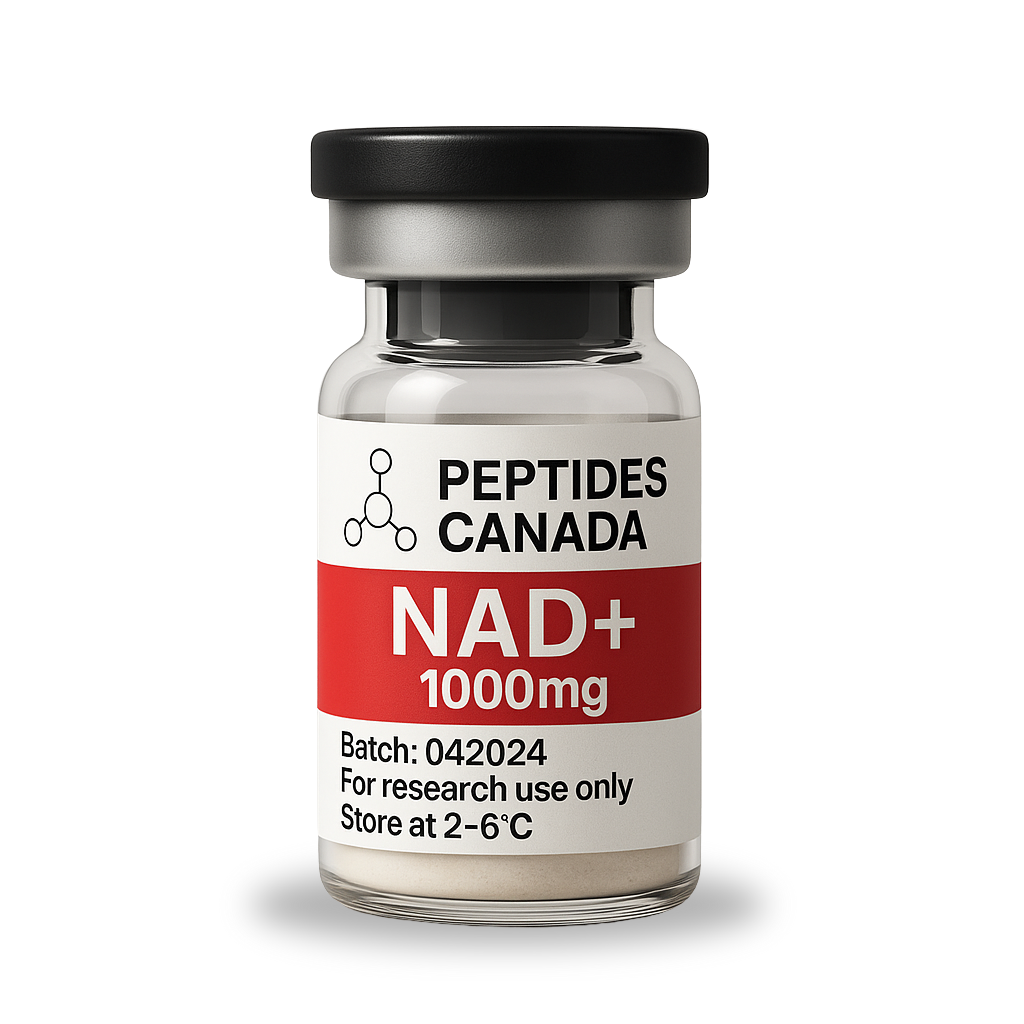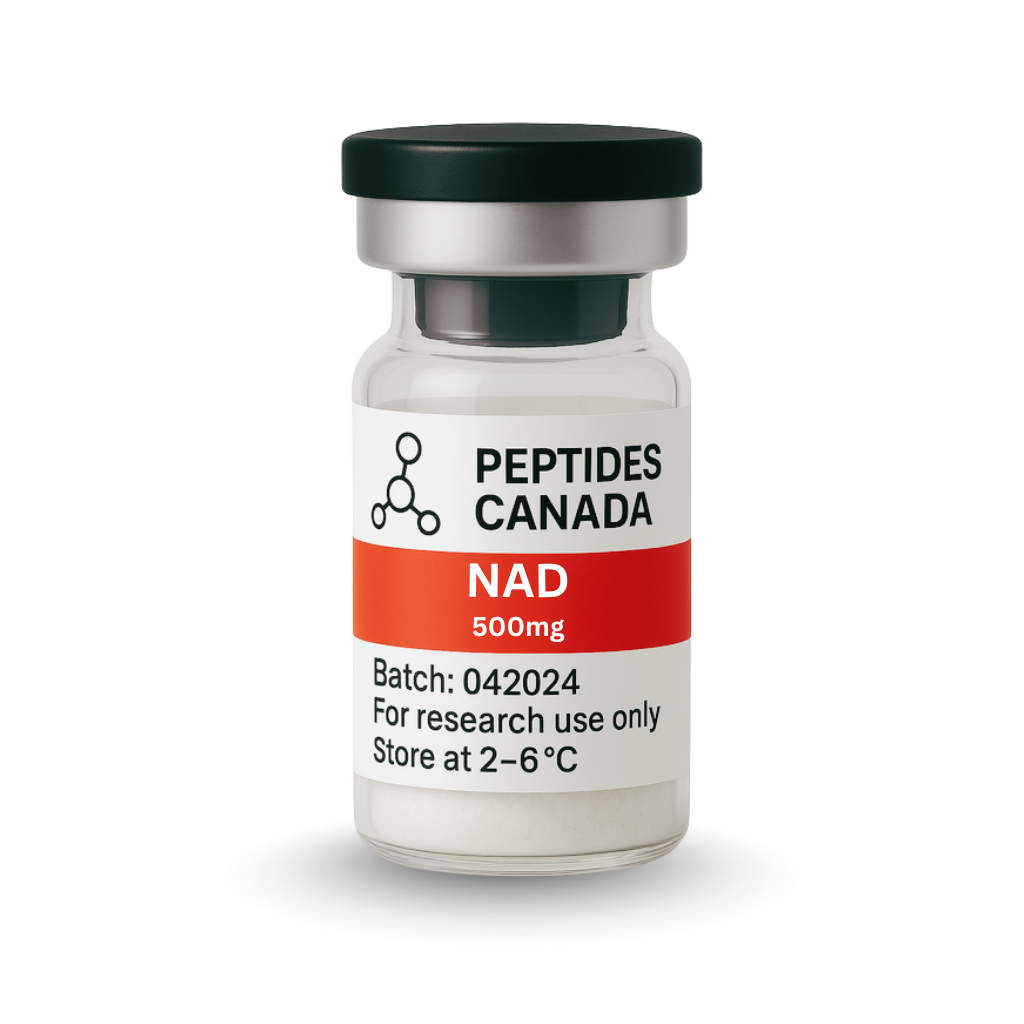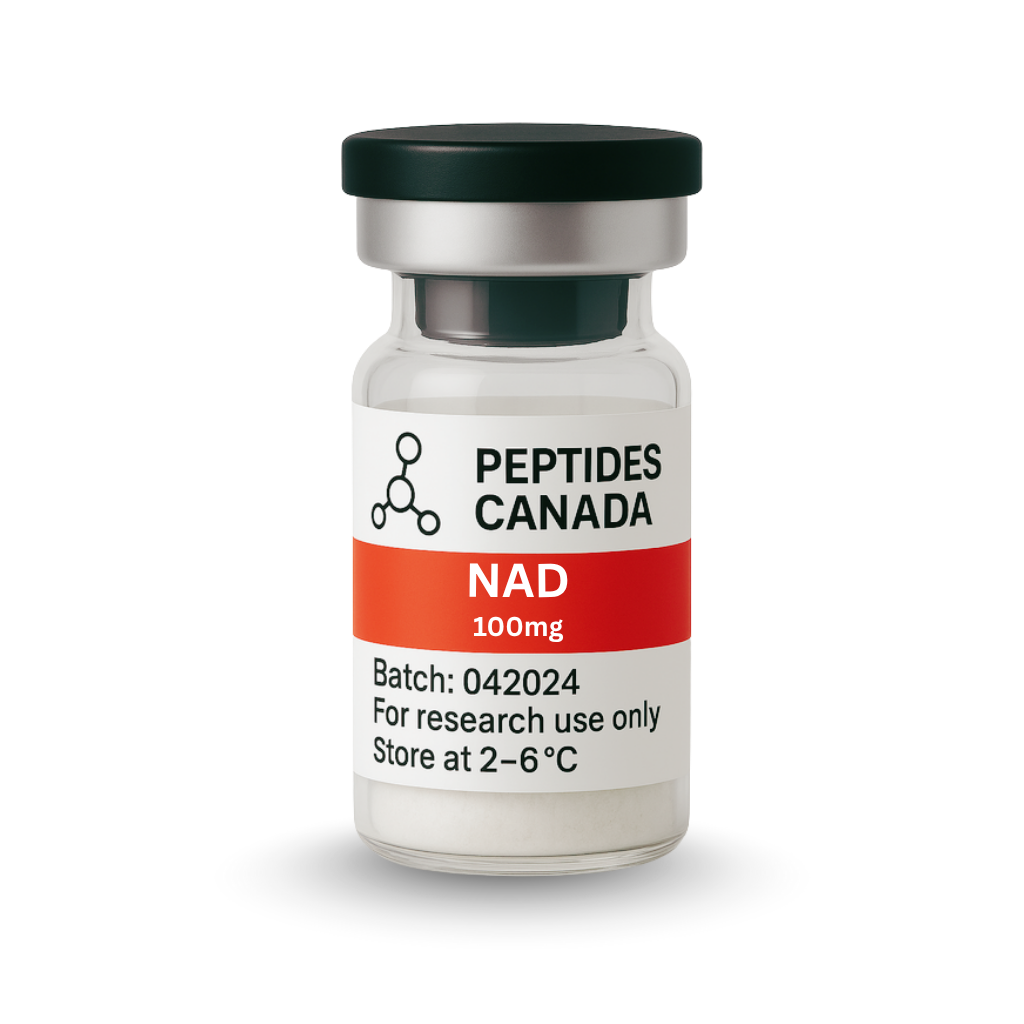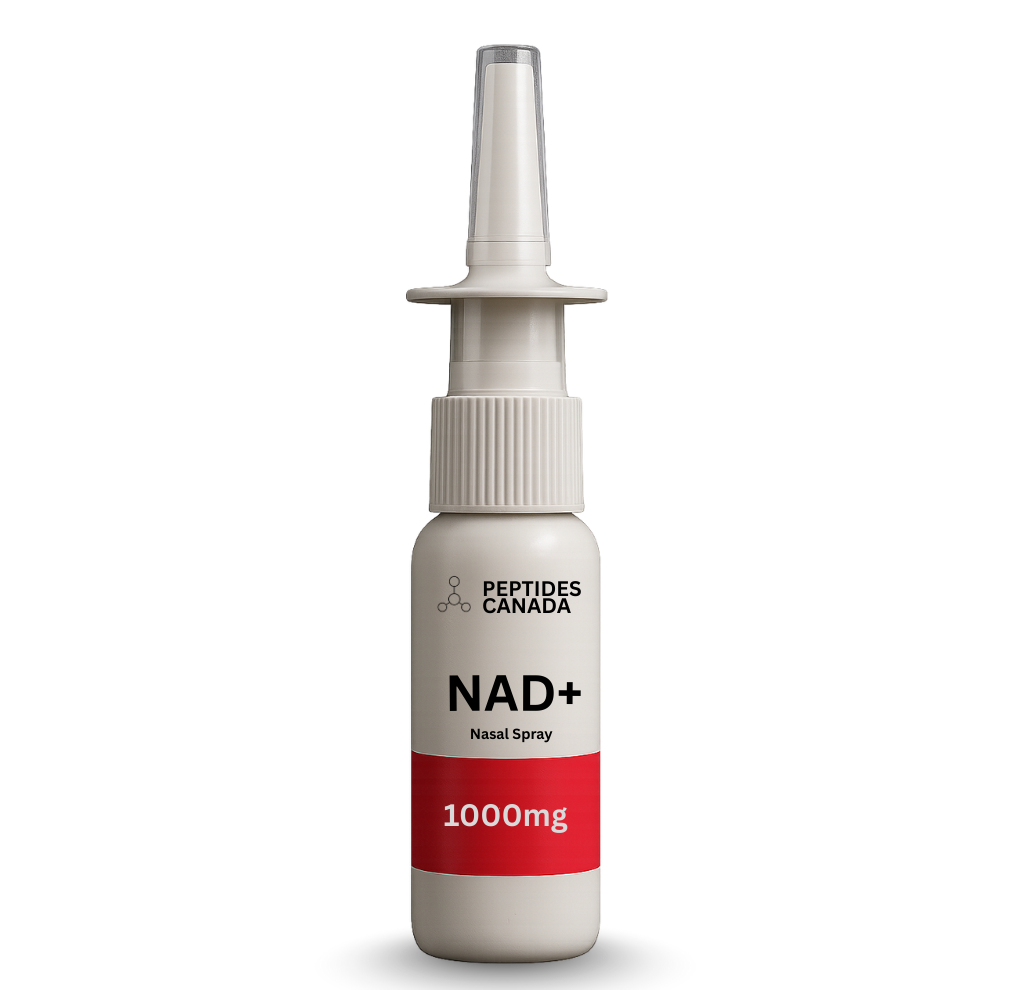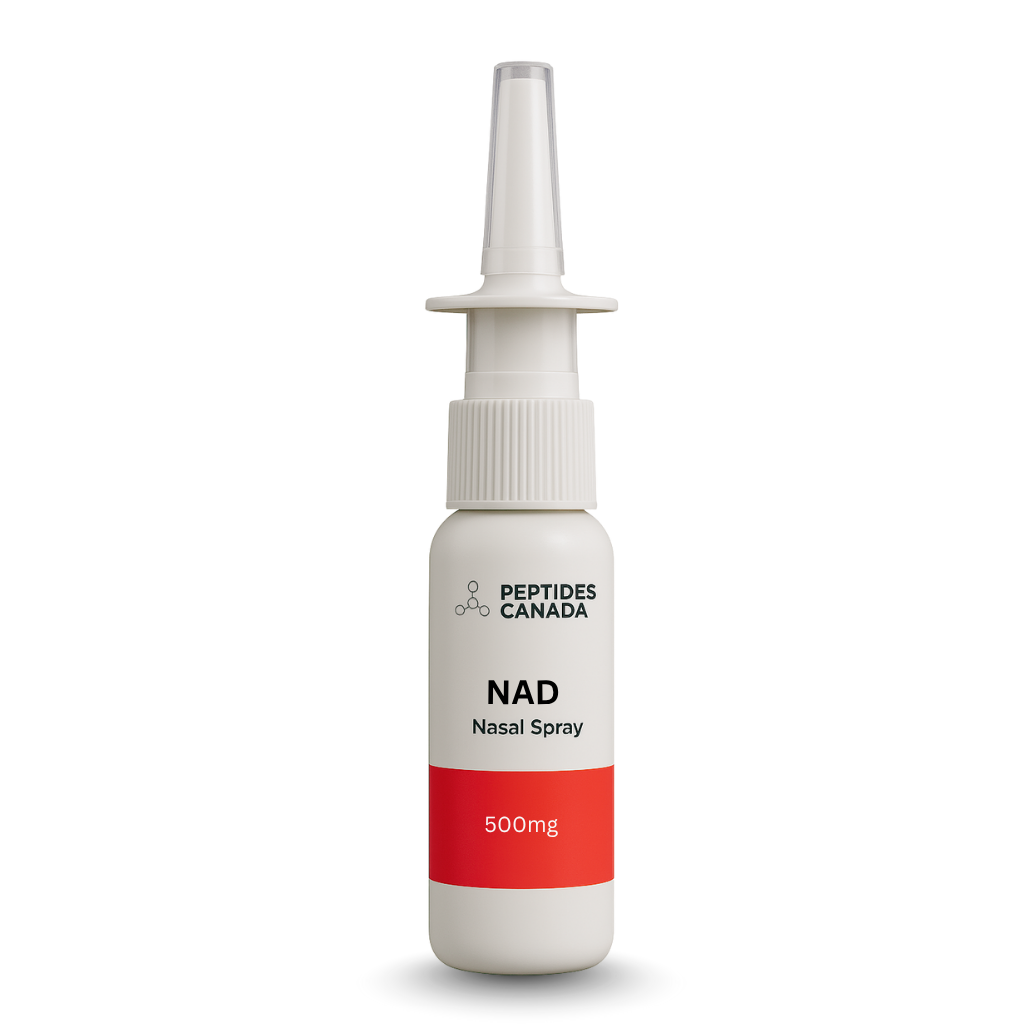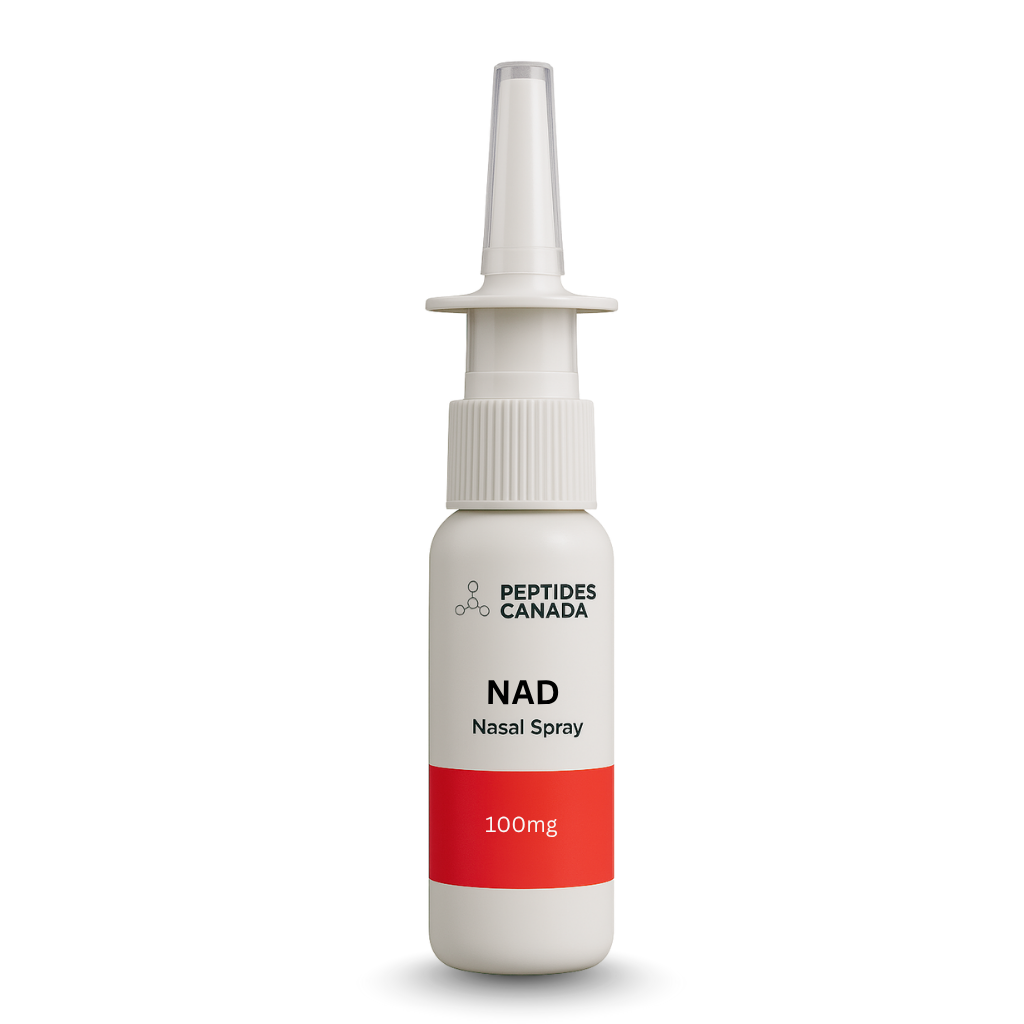NAD+
From CAD $38 CAD $139
Contents: NAD+
Form: Powder
Purity: 99.6%
TESTED FOR:
- PURITY
- STERILITY
- WEIGHT
- ENDOTOXINS(LPS)
Free Reconstitution solution automatically added to your cart with each order of vial.
This product is Made, Tested & Shipped From Canada.
Ships Today
Order by 1:00 PM EST
Free Shipping
For 2 or more vials
99%+ Purity Guaranteed
COA Verified+
Trackable Shipping
NAD+ Peptide
NAD+ stands for Nicotinamide Adenine Dinucleotide, an endogenous nucleotide involved in metabolism, cellular energy production, and DNA repair. It is also discussed as a secondary messenger in calcium-dependent signaling and as an immunoregulatory component. Researchers describe NAD+ synthesis through de novo pathways from tryptophan and through salvage routes that include tryptophan, nicotinamide, nicotinic acid, nicotinamide riboside, and nicotinamide mononucleotide. Once formed, NAD+ participates in numerous enzymatic reactions and cellular processes that support metabolic activity. Functionally, it acts as a coenzyme in redox reactions and can be converted to NADH, the energy-carrying form of NAD+.
Overview
Researchers have suggested that Nicotinamide Adenine Dinucleotide acts as a coenzyme for three major enzyme classes:
-Deacetylase enzymes in the sirtuin class (SIRTs)
-Poly(ADP-ribose) polymerase (PARP) enzymes
– Cyclic ADP ribose synthetase (cADPRS)
Research suggests the following interactions with NAD+:
– SIRTs may support mitochondrial homeostasis, stem-cell maintenance and regeneration, and may counter neural degeneration.
– PARPs, a family of 17 enzymes, can utilize NAD+ to synthesize poly(ADP-ribose) chains that influence genome stability.
– cADPRS includes CD38 and CD157, key immunologic enzymes that hydrolyze NAD+ and may stimulate stem-cell regeneration and DNA repair, processes relevant to the cell cycle.
Because these enzymes depend on NAD+, researchers note that high demand can compete for available NAD+ and influence bioavailability. Balancing NAD+ supply with its consumption may be important for achieving the intended impact of these pathways.
Chemical Makeup
Molecular Formula: C₂₁H₂₇N₇O₁₄P₂
Molecular Weight: 663.43 g/mol
Other Known Titles: Nicotinamide adenine dinucleotide; β-NAD; Coenzyme I; Diphosphopyridine nucleotide
Research and Clinical Studies
NAD+ Peptide and Productive Aging
Two key intermediates in NAD+ biology are nicotinamide riboside (NR) and nicotinamide mononucleotide (NMN). In a 12-month study, normal-aging mice exposed to NMN showed indications consistent with increased NAD+ synthesis and reported changes such as reduced weight gain, higher energy metabolism, increased physical activity, improved lipid profile, and other physiological effects.
NAD+ Peptide and Neurodegenerative Activity
Mitochondrial dysfunction limits electron transport and ATP synthesis in neurodegenerative settings. A study in aged mice exposed to NMN for 3–12 months evaluated mitochondrial respiration with a fluorescent NMN probe. After exposure, oxygen-consumption rates in neural and brain cells suggested restored mitochondrial function, consistent with rapid use of the compound to generate NAD+.
NAD+ Peptide and DNA Repair After Ischemic Stress
In neural culture models subjected to ischemic stress, reintroducing NAD+ improved DNA base-excision repair activity, cell viability, and oxidative DNA-damage repair whether added before or after stress. Mechanistically, PARP enzymes consume NAD+ to attach ADP-ribose units (PARylation) that recruit and activate DNA-repair proteins. Excess damage can overactivate PARP and deplete NAD+, potentially disrupting other NAD+-dependent processes. Supplying NAD+ in these conditions may offset depletion and support DNA repair and survival.
NAD+ Peptide and the Liver, Kidney
Raising circulating NAD+ levels in experimental mice was associated with protective effects in models of obesity and alcoholic hepatitis and with improvements in glucose homeostasis and overall liver function. In aged kidney cells, NAD+ supplementation favored SIRT activity and showed protective potential against glucocorticoid-induced hypertrophy. In models using NMN (an NAD+ intermediate), benefits were also reported against cisplatin-induced kidney injury.
NAD+ Peptide and Skeletal Function
Seven days of NMN exposure in aged mice was associated with increased ATP production, reduced inflammation, and enhanced mitochondrial performance. These observations are consistent with NAD+ functioning as a redox cofactor in cellular respiration: NAD+ accepts electrons to form NADH during glycolysis and the citric-acid cycle, and NADH donates electrons in the respiratory chain to drive oxidative phosphorylation and ATP generation.
NAD+ Peptide and Cardiac Functions
NAD+ deficiency has been linked to reduced SIRT activity, with potential downstream effects on energy production and aortic constriction. In a mouse model, NMN administered 30 minutes before induced ischemia produced a cardioprotective effect against ischemic injury.
NAD+ peptide is available for research and laboratory purposes only. Please review and adhere to our Terms and
Conditions before ordering.
References:
- Schultz, Michael B, and David A Sinclair. “Why NAD(+) Declines during Aging: It’s Destroyed.” Cell metabolism vol. 23,6 (2016): 965-966. https://www.ncbi.nlm.nih.gov/pmc/articles/PMC5088772/
- Braidy N, Liu Y. NAD+ therapy in age-related degenerative disorders: A benefit/risk analysis. Exp Gerontol. 2020 Apr;132:110831. doi: 10.1016/j.exger.2020.110831. https://pubmed.ncbi.nlm.nih.gov/31917996/
- Johnson, Sean, and Shin-Ichiro Imai. “NAD + biosynthesis, aging, and disease.” F1000Research vol. 7 132. 1 Feb 2018. https://www.ncbi.nlm.nih.gov/pmc/articles/PMC5795269/
- Bieganowski P, Brenner C. Discoveries of nicotinamide riboside as a nutrient and conserved NRK genes establish a Preiss-Handler independent route to NAD+ in fungi and humans. Cell. 2004 May 14;117(4):495-502. https://pubmed.ncbi.nlm.nih.gov/15137942/
- Fang, E. F., Lautrup, S., Hou, Y., Demarest, T. G., Croteau, D. L., Mattson, M. P., & Bohr, V. A. (2017). NAD+ in Aging: Molecular Mechanisms and Translational Implications. Trends in molecular medicine, 23(10), 899–916. https://www.ncbi.nlm.nih.gov/pmc/articles/PMC7494058/
- Harden, A; Young, WJ (24 October 1906). “The alcoholic ferment of yeast-juice Part II.–The coferment of yeast-juice”. Proceedings of the Royal Society of London. Series B, Containing Papers of a Biological Character. 78 (526): 369–375. https://royalsocietypublishing.org/doi/10.1098/rspb.1906.0070
- Mills KF, Yoshida S, Stein LR, Grozio A, Kubota S, Sasaki Y, Redpath P, Migaud ME, Apte RS, Uchida K, Yoshino J, Imai SI. Long-Term Administration of Nicotinamide Mononucleotide Mitigates Age-Associated Physiological Decline in Mice. Cell Metab. 2016 Dec 13;24(6):795-806. https://pubmed.ncbi.nlm.nih.gov/28068222/
- Long AN, Owens K, Schlappal AE, Kristian T, Fishman PS, Schuh RA. Effect of nicotinamide mononucleotide on brain mitochondrial respiratory deficits in an Alzheimer’s disease-relevant murine model. BMC Neurol. 2015 Mar 1;15:19. https://pubmed.ncbi.nlm.nih.gov/25884176/
- Safety & Efficacy of Nicotinamide Riboside Supplementation for Improving Physiological Function in Middle-Aged and Older Adults. https://clinicaltrials.gov/ct2/show/NCT02921659
- Braidy N, Liu Y. NAD+ therapy in age-related degenerative disorders: A benefit/risk analysis. Exp Gerontol. 2020 Apr;132:110831. https://pubmed.ncbi.nlm.nih.gov/31917996/
- Wang S, Xing Z, Vosler PS, Yin H, Li W, Zhang F, Signore AP, Stetler RA, Gao Y, Chen J. Cellular NAD replenishment confers marked neuroprotection against ischemic cell death: role of enhanced DNA repair. Stroke. 2008 Sep;39(9):2587-95. https://pubmed.ncbi.nlm.nih.gov/18617666/
- Rajman, Luis et al. “Therapeutic Potential of NAD-Boosting Molecules: The In Vivo Evidence.” Cell metabolism vol. 27,3 (2018): 529-547. https://www.ncbi.nlm.nih.gov/pmc/articles/PMC6342515/
- Heer C, et al, Coronavirus infection and PARP expression dysregulate the NAD metabolome: An actionable component of innate immunity. Journal of Biological Chemistry. Volume 295, Issue 52, Dec 2020. https://www.jbc.org/article/S0021-9258(17)50676-6/fulltext
- Mehmel, Mario et al. “Nicotinamide Riboside-The Current State of Research and Therapeutic Uses.” Nutrients vol. 12,6 1616. 31 May. 2020, doi:10.3390/nu12061616 https://www.ncbi.nlm.nih.gov/pmc/articles/PMC7352172/
- Leung A, Todorova T, Ando Y, Chang P. Poly(ADP-ribose) regulates post-transcriptional gene regulation in the cytoplasm. RNA Biol. 2012 May;9(5):542-8. doi: 10.4161/rna.19899. Epub 2012 May 1. PMID: 22531498; PMCID: PMC3495734.
- Croteau DL, Fang EF, Nilsen H, Bohr VA. NAD+ in DNA repair and mitochondrial maintenance. Cell Cycle. 2017 Mar 19;16(6):491-492. doi: 10.1080/15384101.2017.1285631. Epub 2017 Feb 1. PMID: 28145802; PMCID: PMC5384578.
Dr. Marinov
Dr. Marinov (MD, Ph.D.) is a researcher and chief assistant professor in Preventative Medicine & Public Health. Prior to his professorship, Dr. Marinov practiced preventative, evidence-based medicine with an emphasis on Nutrition and Dietetics. He is widely published in international peer-reviewed scientific journals and specializes in peptide therapy research.
HIGHEST QUALITY PEPTIDES
Our products are scientifically formulated and manufactured in cGMP-compliant facilities.
FAST DELIVERY
Enjoy fast and reliable 3–5 day shipping.
Dedicated Customer Service
Our customer service team is highly knowledgeable in peptide research and its applications. We’re available 24/7 to assist you.
Tested. Verified. Trusted.
We take a laboratory-first approach to quality. Each batch is made under controlled conditions and verified by an independent lab (HPLC/MS). We only ship batches that test ≥99% purity, and we provide a full COA, including identity, methods, and chromatograms, for your review.
See the Process for Yourself
We make our peptides in our own cGMP lab. Watch the video to see how every vial is produced, tested, and handled with care.
Science Behind Our Peptides
A clear explanation of how our peptides work, their benefits, why quality matters for best results, and what you should know.
Categories
Categories
How do I know the peptides I order are exactly what the label says?
Every vial we sell comes from a lab that follows current Good Manufacturing Practices (cGMP). That means each step of production is documented and controlled. Before a batch is released, it’s tested by independent third-party labs for purity, identity, and sterility. Certificates of analysis are available so you can see the exact test results.
Are your peptides produced in a sterile and controlled environment?
Yes. The labs we work with use ISO-certified clean rooms where air quality, equipment, and handling procedures are tightly regulated. Staff are trained to pharmaceutical-grade standards. This ensures the peptides are produced in an environment that minimizes contamination risks.
What about shipping? Do the peptides remain stable in transit?
Peptides in lyophilized (freeze-dried) form are stable at room temperature for transport. Once you receive them, refrigeration is recommended to maintain long-term integrity. We package every order securely to prevent damage and ship promptly, so your vials arrive in optimal condition.
How do I know you actually make these peptides yourselves?
We operate under strict in-house protocols that follow current Good Manufacturing Practices (cGMP). That means our team oversees the entire process from sourcing raw amino acids to the final lyophilized vial. Nothing is outsourced or repackaged. This gives us full control over purity, consistency, and sterility, and it’s why we can stand behind every single vial we ship.
What should I do with the vials once they arrive?
Store them in the refrigerator, away from direct light and heat. If you need to keep them longer, some peptides can be stored frozen. Each vial comes with clear handling instructions so you know the proper conditions for stability.
What proof do you have that your peptides are legitimate?
The strongest proof is transparency. For every peptide, we can provide certificates of analysis, manufacturing documentation, and references to the published scientific research behind it. If you ever have questions, we’ll show you the data rather than ask you to take our word for it.

